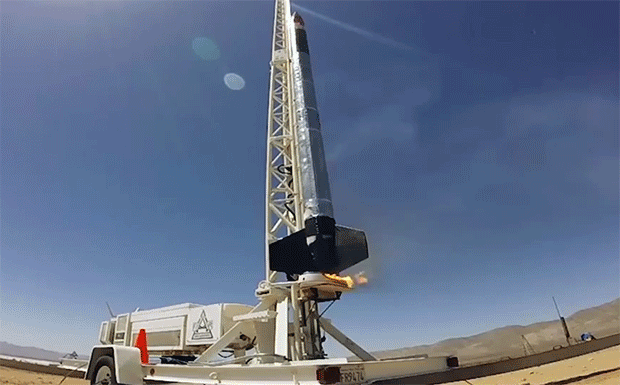

The San Diego State University (SDSU) Rocket Team’s rocket was leaking fuel. Project manager Manny Marinas cut the countdown by half, yelling at his teammates to launch the thing before their window closed, before too much fuel spilled out.
His teammate got the message, and the rocket took off, cruising to 13,000 feet. Somewhere along the way, it caught fire.
“There were problems, but we were able to troubleshoot everything pretty quickly,” says Marinas. “I would say we were really prepared for most of the events that happened that day.”
It was a clear day in April, one day before we experienced Carbon Origins’ test flight of their Phoenix 0.3 rocket. While Carbon Origins designed some Maker technology for use in rocketry and DIY space exploration, the SDSU team was leveraging existing Maker tech for their launch, and all of it, along with a year’s worth of effort by the team, was currently burning.
With the optimism of hindsight, Marinas points out that the launch was really quite successful. Their late-night launch sequence practice sessions paid off, allowing them to get it off the ground quickly. And the data from their sensors confirmed that it was, in fact, on fire.
“That moment right there is the most important part of our entire over-a-year-long struggle of working day and night on this rocket,” says Marinas. “It’s very rewarding to see it work, it didn’t explode. It did catch on fire, unfortunately, but everything worked.”
The SDSU Rocket Project is a club of up to 45 members that spends a year building a rocket and launches it at the Friends of Amateur Rocketry site outside Mojave, California. This year, their rocket was 27′ long and 11″ in diameter, and named Galactic Aztec, after one of the team’s sponsors and the SDSU mascot.
“The entire rocket is built from scratch, basically,” says Ryan Callahan, prototyping section lead for the Rocket Project. “The majority of our electronics were open source. We appreciate when we can take stuff like that, modify it to our needs, hack it, and make it do exactly what we need it to do.”

They designed custom PCBs and had them printed by OSH Park. They recently acquired a LulzBot TAZ 5, which revolutionized not only their design, but also the build. Callahan said it was less about prototyping and more about printing brackets, enclosures, bushings, and then iterating upon their shapes.
At the time of launch, there were eight active Raspberry Pis, including two on the ground, says Travis Wyatt, who worked on the electronics. Two years prior, the team used old Android phones as flight controllers, but upon learning about Raspberry Pis (and their low cost), the team piled on more and more Pis onto subsequent rockets, and used them to run sensors, cameras, and even to control the launch itself.

“It was all custom-designed electronics, and how it interacted with the software was pretty interesting. We stacked a bunch of boards,” says Wyatt. “It all fit together nicely and modularly.”
The on-board sensors were typical of rockets of that size: barometer, gyro, accelerometer, GPS, magnetometer, and pressure sensors (for each tank, and on the motor to do thrust calculations). The Pi cameras fed the video in real time to the bunker and handled the launch command, but didn’t control any in-flight actions. That’ll come next year; the team’s ambition for 2016 is a gimbal for the engine that will allow them to control thrust and vector. Callahan will be back next year as design lead, and Marinas will be project manager again.
Marinas did most of the carbon fiber molding for the Galactic Aztec, something he had experienced while interning for an aerospace composite fabrication company, but instead of the pre-preg lay-ups his company did, the team used wet lay-up, like Virgin Galactic uses. For the boat tail (which eventually caught on fire), he used a hot wire to cut foam core, reinforced it with fiberglass, and laid on the carbon, to make rocket more aerodynamic and give the fins purchase for mounting.

Near the fins (inside the rocket) was a LR101 motor from Rocketdyne, filled with liquid oxygen and RP-1 kerosene. Callahan points out that NASA and SpaceX use liquid fuel: “if we’re trying to get into that industry, we figure we better know and learn how to build liquid fuel rockets.”
In addition to Facebook and the SDSU website, the source code for the data acquisition units is on Wyatt’s GitHub, as is all the data they collected.
“When that thing took off, and the parachute deployed, it was like, time froze,” says Callahan. “It was a moment for all of us, especially the ones, all of us who live, breathe, eat, sleep this stuff, to see all our hard work come to fruition like that, it was really a great moment.”
ADVERTISEMENT






